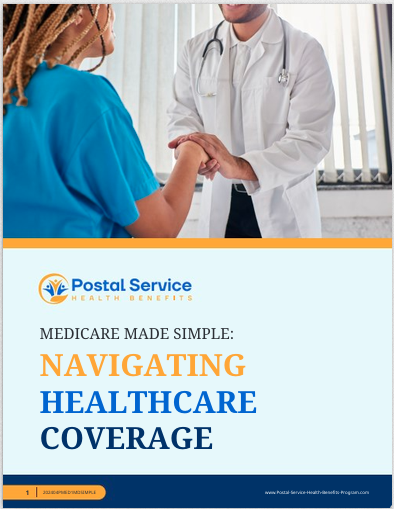Key Takeaways:
-
Medicare Part B enrollment is a critical factor in maintaining comprehensive coverage under the Postal Service Health Benefits (PSHB) program.
-
Understanding costs, benefits, and integration with PSHB ensures you make the best decisions for your healthcare needs as a postal retiree.
Why Medicare Part B Matters for PSHB Enrollees
If you’re a postal retiree or planning to retire soon, understanding the role of Medicare Part B in the Postal Service Health Benefits (PSHB) program is essential. Medicare Part B, which covers outpatient and preventive services, works hand-in-hand with your PSHB plan to provide extensive healthcare coverage. Knowing how these systems align will help you avoid unexpected costs and ensure you maximize your benefits.
PSHB and Medicare Integration: The Basics
Starting January 2025, the transition from the Federal Employees Health Benefits (FEHB) system to PSHB introduced changes for Postal Service retirees. One of the most significant updates is the integration of Medicare Part B for retirees and their eligible family members who are Medicare-eligible.
Enrollment Requirements
Most Medicare-eligible retirees and family members must enroll in Medicare Part B to maintain their PSHB coverage. However, there are exceptions. For example, if you retired before January 1, 2025, or turned 64 before that date, you may not be required to enroll in Part B.
Coordination of Benefits
When enrolled in both PSHB and Medicare Part B, Medicare typically becomes your primary payer, handling most of your medical costs. PSHB acts as the secondary payer, covering deductibles, copayments, and coinsurance not covered by Medicare. This layered coverage significantly reduces your out-of-pocket expenses for medical care.
What Medicare Part B Covers
Medicare Part B is specifically designed to cover outpatient services, such as:
-
Doctor visits, including specialists
-
Preventive services, like screenings and vaccines
-
Laboratory tests and imaging (e.g., X-rays, MRIs)
-
Durable medical equipment (e.g., wheelchairs, walkers)
-
Mental health services, including counseling
-
Outpatient surgeries and procedures
Understanding these benefits is vital because many of these services are among the most frequently used by retirees.
Costs Associated with Medicare Part B
While Medicare Part B offers robust coverage, it does come with costs that you should consider when budgeting for retirement. As of 2025, the standard monthly premium is $185. However, higher-income retirees may face additional costs due to the Income-Related Monthly Adjustment Amount (IRMAA).
Deductibles and Coinsurance
Beyond premiums, Medicare Part B has an annual deductible of $257 in 2025. Once the deductible is met, Medicare covers 80% of approved services, leaving you responsible for the remaining 20%. Fortunately, with PSHB acting as a secondary payer, many of these out-of-pocket costs can be minimized or eliminated.
How PSHB Complements Medicare Part B
PSHB plans are specifically designed to work seamlessly with Medicare. Here’s how:
-
Reduced Out-of-Pocket Costs: PSHB plans often waive deductibles and reduce copayments for enrollees who also have Medicare Part B.
-
Prescription Drug Coverage: Many PSHB plans include Medicare Part D benefits, offering comprehensive prescription drug coverage with an out-of-pocket cap of $2,000 in 2025.
-
Lower Premium Contributions: Some PSHB plans offer premium incentives or reimbursements for enrollees with Medicare Part B.
Should You Enroll in Medicare Part B?
For most postal retirees, enrolling in Medicare Part B is a wise decision. However, the choice depends on your unique circumstances.
Advantages of Enrolling
-
Comprehensive Coverage: Combining Medicare Part B with PSHB ensures you’re covered for a wide range of services, minimizing gaps in care.
-
Cost Savings: With Medicare as your primary payer, your PSHB plan will pick up secondary costs, potentially saving you thousands of dollars annually.
-
Access to Preventive Services: Medicare Part B offers many preventive services at no additional cost, helping you stay healthy in retirement.
Potential Drawbacks
-
Premium Costs: The monthly premium for Medicare Part B can be a significant expense, particularly for retirees on a fixed income.
-
Enrollment Penalties: If you delay enrollment and later decide to join, you may face a lifelong penalty, increasing your premium by 10% for each year you were eligible but did not enroll.
Enrollment Timelines and Deadlines
Understanding when and how to enroll in Medicare Part B is crucial to avoid coverage gaps or penalties.
Initial Enrollment Period (IEP)
Your IEP lasts for seven months, starting three months before you turn 65, including your birth month, and ending three months afterward. Enrolling during this period ensures you avoid late enrollment penalties.
General Enrollment Period (GEP)
If you miss your IEP, you can enroll during the GEP, which runs from January 1 to March 31 annually. However, coverage begins July 1, and you may face penalties.
Special Enrollment Period (SEP)
If you’re still working and covered by an employer-sponsored plan, you may qualify for an SEP. This period allows you to enroll in Medicare Part B without penalties once your employer coverage ends.
Navigating Enrollment and Integration
Enrolling in Medicare Part B and integrating it with your PSHB coverage doesn’t have to be complicated. Here are steps to ensure a smooth process:
-
Check Your Eligibility: Confirm whether you’re required to enroll in Medicare Part B to maintain PSHB coverage.
-
Budget for Costs: Account for premiums, deductibles, and coinsurance when planning your retirement budget.
-
Coordinate with PSHB: Review your plan’s brochure to understand how it integrates with Medicare Part B and what benefits are available.
-
Enroll on Time: Ensure you meet enrollment deadlines to avoid penalties or lapses in coverage.
-
Stay Informed: Keep an eye on annual updates to Medicare and PSHB, as costs and benefits may change.
The Financial Impact of Medicare and PSHB Integration
Combining Medicare Part B with PSHB can significantly reduce your healthcare costs in retirement. By coordinating benefits, you’ll have:
-
Lower Out-of-Pocket Expenses: Reduced costs for doctor visits, hospital stays, and prescriptions.
-
Predictable Costs: Annual out-of-pocket caps help you plan for healthcare expenses without surprises.
-
Enhanced Access to Care: Broader provider networks and additional services ensure you receive the care you need.
Planning Ahead for Future Changes
Healthcare policies and costs are subject to change. Staying proactive and informed will help you navigate any adjustments to Medicare or PSHB. Key steps include:
-
Reviewing your Annual Notice of Change (ANOC) letter each fall.
-
Attending informational sessions or webinars during Open Season.
-
Consulting with benefits counselors or financial planners to optimize your coverage.
Maximizing Your Postal Retiree Benefits
Understanding the role of Medicare Part B in your PSHB plan is essential for managing your healthcare in retirement. By enrolling in Medicare Part B, coordinating it with your PSHB coverage, and staying informed about updates, you can enjoy comprehensive and cost-effective healthcare for years to come.






